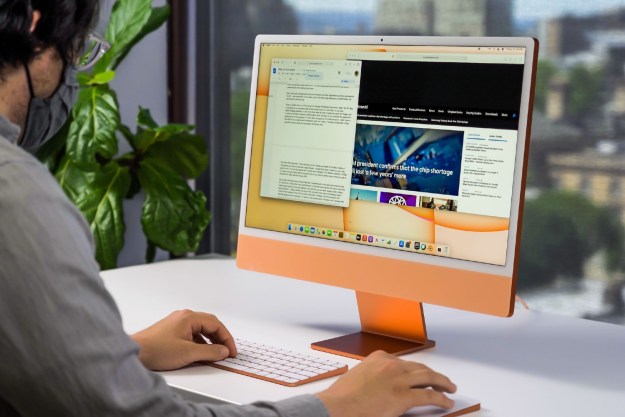
|
Surface Studio  |
iMac (2016)  |
|
| Display & Dimensions | 28-inch PixelSense touch | 21.5-inch Retina 4K or 27-inch Retina 5k |
| Processor | 6th-gen Intel Core i5 or i7 | 6th-gen Intel Core i5 or i7 (27-Inch) or 5th-gen Intel Core i5 or i7 (21.5-inch) |
| Operating System | Windows 10 Pro | MacOS Sierra |
| GPU | Nvidia GeForce GTX 965M 2GB or 980M 4GB | Intel HD Graphics 6000 up to AMD Radeon R9 M395 4GB |
| RAM | 8GB, 16GB, or 32GB | 8GB, configurable up to 32GB |
| Hard drive | 1TB or 2TB rapid hybrid drive | 1TB hard drive or 2TB fusion drive; configurable up to 3TB fusion drive or 1TB SSD |
| Ports | USB 3.0 (x4), Mini Displayport, Ethernet, SD card reader | USB 3.0 (x4), Thunderbolt (x2), gigabit Ethernet, SDXC card slot |
| Wireless | 802.11ac Wi-Fi, Bluetooth 4.0, Xbox Wireless built-in | 802.11ac, Bluetooth 4.0 |
| Cameras | 5.0MP front-facing 1080p with Windows Hello support | FaceTime HD camera; supports full native resolution |
| Speakers | Stereo 2.1 with Dolby Audio Premium | Stereo speakers |
| Microphones | Dual microphones | Dual microphones |
| Price | $2,999+ | $1,099+ |
| Availability |
Available for pre-order now, ships December 15. |
Available now |
| DT review | N/A |
Hardware
The Surface Studio is packing Intel 6th-generation Core quad-core processors. Apple’s iMac packs similar in the 27-inch model, but the 21.5-inch model has a 5th-generation Intel Core i5 quad, with optional upgrade to Core i7. That means the smaller iMac is slower, but given the substantial size gap, that’s not too much of an issue.
Both computers include high-end graphics cards (assuming you have the 27-inch iMac) that can be beefed up to 4GB of GDDR5 memory. The Studio’s Nvidia GeForce GTX 965M is newer and quicker than the AMD Radeon R9 cards in the iMac, however. And if you really want to boost your graphics, you can buy a GTX 980M for the Surface Studio.
Display

The Retina display on the 27-inch iMac is a thing of beauty. The 5K model features 5,120 x 2,880-pixel resolution with support for millions of colors, powered by an AMD Radeon R9 graphics card that can be beefed up to an M395X with 4GB of memory.
Even considering the UHD beauty of the iMac, though, the Surface Studio is no slouch. Its 28-inch, PixelSense touch display features a 4,500 x 3,000-pixel resolution, meaning that the Studio’s screen houses about 13.5 million pixels. With 10-point multitouch, the screen can separately identify eight fingers and two thumbs — simultaneously. For reference, most modern smartphones feature 2-point multi touch systems.
The Surface Studio boasts an unusual 3:2 aspect ratio, which was implemented to support the pixel density, clocking in at an incredible 192 ppi. The screen’s sharpness is largely in service to color; more specifically, Windows has a built-in feature allowing the user to switch between color spaces, including DCI-P3 and sRGB. It’s a neat feature that allows artists and designers to preview their work under different parameters. The Surface Studio also includes the Surface Pen and the new Surface Dial, tools designed to improve the computer’s touch-screen experience and design accessibility; we’ll go into that a bit later on.
In the end, both displays look great. The iMac is sharper, but the Surface Studio’s color is excellent, and the ability to switch color gamuts through the touch of an on-screen button is great for creative professionals.
Connectivity and features

Both computers offer four USB-3 ports, Ethernet ports, and SD card readers. The iMac, unsurprisingly, is outfitted with dual Thunderbolt 2 ports, while the Surface Studio includes a mini-DisplayPort — though, we’re not sure why you’d want to use any other screen. Each computer is also outfitted with 802.11ac Wi-Fi connectivity and Bluetooth 4.0. The Surface also includes native Xbox Wireless, a reflection of Microsoft’s Play Anywhere initiative.
The Surface’s native camera is superior to the iMac’s, though not by much. The Windows Hello sign-in camera can automatically recognize your face and automatically sign you into your computer. It’s not a new feature, but a welcome one all the same. The Studio’s camera supports 1080p, while the FaceTime HD camera is limited to 720p.
Design

Here’s where Microsoft justifies the astronomical price tag that they’ve affixed to the Surface Studio. The Studio is built for art, whether you’re a graphic designer or an architect. The massive 28-inch touchscreen is mounted on a Zero Gravity Hinge, which allows the display to be shifted up and down, or from your face to your desk. Placing the computer in “design mode” — with the screen tilted back — allows the user to take full advantage of the Surface Pen and the Surface Dial.
The hockey-puck-shaped Dial looks innocent enough, but it really shines when plopped onto the screen itself. It clicks and spins — with haptic feedback, so you can feel any changes as they happen — and when you place it onto the display, touch-sensitive menus will automatically pop up around the dial. For instance, turning the dial while drawing might change the color of your digital pencils or the size of your digital brush.
The Surface Pen offers the same functionality here as it does on popular tablets such as the Surface Pro 4, providing the user with a diverse set of touch-based tools. The Studio also comes with the new Surface Ergonomic Keyboard, an oddly-shaped thing that continues Microsoft’s pattern of keyboards split down the middle. Built for a more comfortable typing experience, it’s got a wrist pad made of synthetic suede, and two space bars.
The iMac is also gorgeous, though. There’s nothing new here from a design perspective, but Apple’s products continue to get thinner and more capable with every build. The machine’s curved, silver body becomes 5-millimeters thick at the edges of the display, and the Retina panel measures just 1.4-millimeters thick across the screen. The iMac ships with Apple’s standard Magic Mouse and Keyboard.
Availability and price
The Surface Studio is available for pre-order now, and hits shelves on December 15. The Studio comes in three flavors — $2,999, $3,499, and $4,199. The $2,999 version includes a Core i5 processor, while the other two are outfitted with a Core i7. Choosing a more expensive option will also net you more RAM and more storage space. The Surface Studio is an investment, and it’s meant for creative minds that will use the Pen, Dial, and all the bells and whistles.
The iMac is available now, and prices range from $1,099 (for the 21.5-inch model) to $2,299 (for the 27-inch Retina display model). Additional configurations and updated components will cost you extra.
Conclusion
If you’re serious about investing in a computer — especially if you’re an artist, a designer, or anything similar — you should go with the Surface Studio.
On the other hand, if you’re not looking to sacrifice your kids’ Christmas presents in order to finance your new computer, check out the iMac. It’s still an awesome piece of technology, one that can be nearly as capable with the right configuration.
All things considered, most people will find that the iMac is a better fit, simply because the Surface Studio’s price is justified largely by its bevy of creative tools and features. Those that don’t need the Surface Dial and Pen shouldn’t shell out a few thousand dollars extra, as the Studio is a specialist’s tool, not a simple everyday PC.
Editors' Recommendations
- The 5 best iMac alternatives in 2024
- Apple just dashed our iMac hopes and dreams
- The M3 iMac is here, but it’s missing its most requested change
- Apple’s refreshed iMac may be coming sooner than you think
- Want a new iMac? It’s just been delayed to 2024, says analyst


